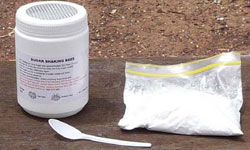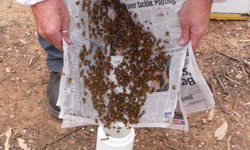Sugar shake test to detect Varroa mite
Varroa mite (Varroa destructor and Varroa jacobsoni) is a serious, exotic parasite of adult European honey bees and their brood.
There are several surveillance projects for early detection of an incursion of Varroa mite at and near shipping ports.
Beekeepers are encouraged to test their own hives for Varroa mite using the simple sugar shake (or roll) test.
When the mites are dusted with pure icing sugar, the fine granules stick to their feet and they can no longer grip the surface they are clinging to.
The dusting of adult bees with icing sugar causes mites to fall off the bee into the white sugar where they are more easily seen.
This simple sugar shake detection method is now used by many beekeepers throughout Australia.
The collection of bees from hives, as described below, may agitate hive bees, including guard bees. People inexperienced in handling bees should first read Safe beekeeping practices.
Make sure you understand safe handling techniques before opening a hive. It's essential that you wear protective clothing when collecting bees for the sugar shake test.
Equipment for sugar shake test

- one 500 gram or 750 gram jar with a plastic or metal lid and mesh or drilled holes (50-70 holes) approximately 3 to 4 mm in size in the lid
- pure icing sugar (do not use icing mixture)
- plastic tablespoon for measuring icing sugar
- sheets of newspaper
- white or light coloured bucket
- fine close-weaved household cleaning cloth or coffee filter paper
- bee smoker, hive tool and protective clothing
- magnifying lens (if available)
- waterproof felt marking pen.
 Method
Method
- Half fill the bucket with clean water.
- Place a heaped tablespoon of icing sugar into the jar after removing.
- Light a smoker and open a hive to be tested.
- Shake some bees from 3 combs containing honey bee brood onto a double thickness of newspaper or upturned hive lid placed on the ground. If brood is not present, shake bees from 1 comb taken from the centre of the cluster of bees. If you find the queen on these combs, place her back into the hive.
- Scoop or pour about 300 bees (half a cup) into the jar. Place the lid on the jar to prevent bees from escaping.
 Vigorously rotate the jar for 2 minutes ensuring all bees are dusted with sugar. Wait 2 to 3 minutes, and rotate the jar a second time for 2 minutes. Be careful not to lose any sugar. (You can reassemble your hive during this waiting period).
Vigorously rotate the jar for 2 minutes ensuring all bees are dusted with sugar. Wait 2 to 3 minutes, and rotate the jar a second time for 2 minutes. Be careful not to lose any sugar. (You can reassemble your hive during this waiting period).- Shake the icing sugar (and any mites) through the holes in the lid into the bucket half filled with water. The sugar will dissolve and any mites will float on the surface of the water. Do the shaking in a sheltered position protected from strong wind that could blow mites away.
- Release the bees from the jar onto the ground close to the hive entrance in case the queen is present.
 Looking for varroa and collection of specimens
Looking for varroa and collection of specimens
- Examine the empty shaker jar and lid for Varroa mite. The mites are reddish-brown – 1.1 mm long and 1.7 mm broad.
- Inspect the water surface for Varroa mite, other mites and insects. If you find any, carefully place them into a small jar with methylated spirits and place the jar in a cool position away from sunlight.
- Alternatively, pour the water through a piece of light-coloured fine, close-weaved household cleaning cloth, or coffee filter paper. Inspect the cloth or filter paper for Varroa mite, other mites and insects. If any of these are present or suspected to be present, place and seal the filter cloth or filter paper in a small ziplock plastic bag or other sealable container.
- Use a waterproof pen to label the specimen jar or ziplock bag and the hive tested with the same number for later identification.
Steps if you find or suspect presence of varroa in your apiary
It is important that when Varroa mite is found or even suspected to be present in an apiary that it is not spread to another apiary.
The following steps will help to reduce the risk of spreading it:
- Don't mail or forward any Varroa mite (and other mites and insects), until advised by an apiary officer from the department. Never take live specimens from the apiary as this may help to spread the parasite or pest.
- Don't remove bees or any hive components from this apiary as this could help spread the mite.
- Place overalls, veil, gloves (and gauntlets) and hat in a plastic bag and leave them at the apiary site until advised by our apiary officer.
- Before leaving the apiary, inspect your vehicle to make sure that there are no bees trapped inside or on the radiator. Spray and remove any bees that could be carried from the apiary. Check the tray of the truck, ute or trailer as well. Any boxes of combs and other hive material on your vehicle which bees might have entered must be left at the apiary.
- Thoroughly wash your hands, hive tool, smoker and any other equipment to ensure Varroa mite is not carried from the apiary.
- Use a fine-toothed comb or brush to remove any mites that may have lodged in your hair or beard.
- Check clothing for any 'passenger' bees that could be carried by you when leaving the apiary. If another person is with you, have them check your clothing for passenger bees.
Notifiable disease
If you see or suspect Varroa mite is present in your apiary, you must notify an apiary officer without delay and by the quickest means possible.
The easiest way to do this is to ring the Exotic Plant Pest Hotline on 1800 084 881 (24 hours a day, every day of the year).
Notification is required by the Livestock Disease Control Act 1994. If you don't notify us – you break the law.
Early reporting and recognition of varroa is one of the most important ways of controlling this parasite and reducing its economic and social impact on the whole community.
Further information
If you require any assistance please email honeybee.biosecurity@agriculture.vic.gov.au or phone the Customer Service Centre on 136 186